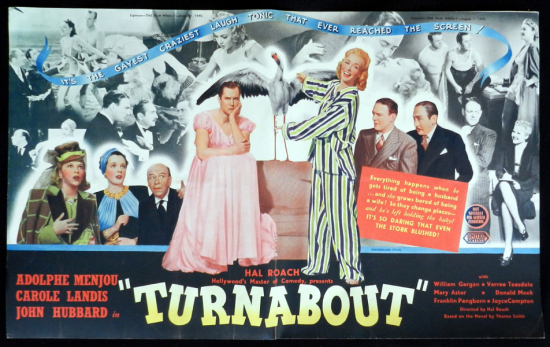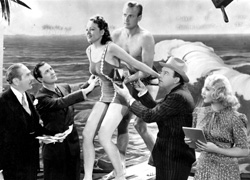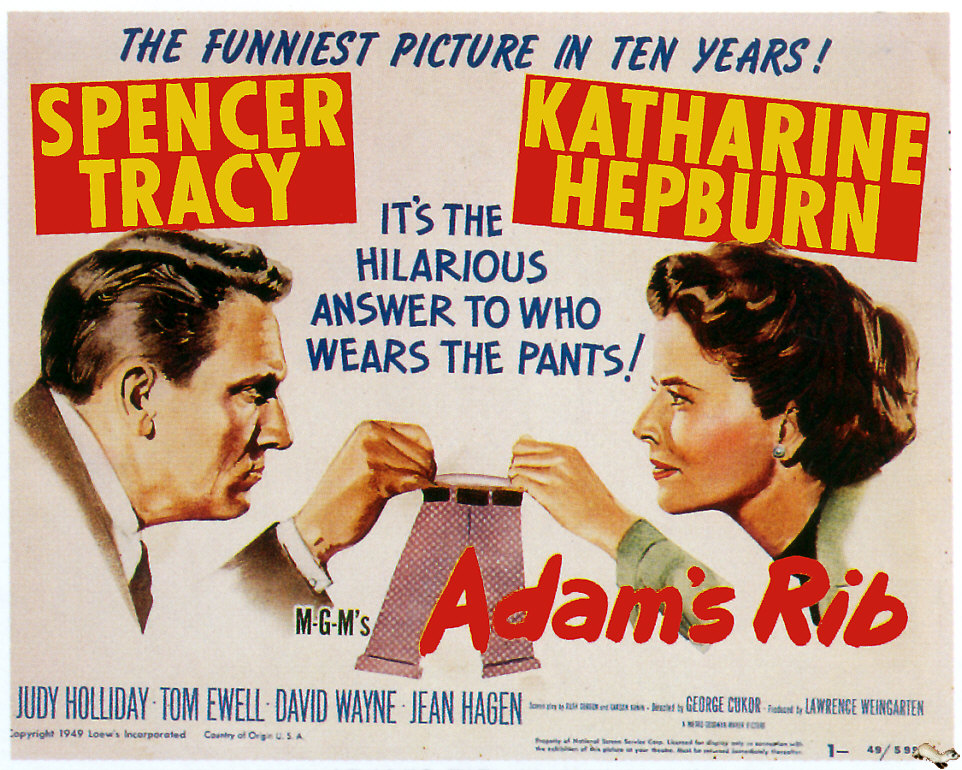Written for The Unquiet American: Transgressive Comedies from the U.S., a catalogue/collection put together to accompany a film series at the Austrian Filmmuseum and the Viennale in Autumn 2009. — J.R.
TURNABOUT (1940)
A bickering husband and wife (John Hubbard and
Carole Landis) switch bodies and lives (but not voices)
after encountering a Buddhist curse. Hal Roach
directed this extremely odd 1940 comedy -– the only
feature I’ve selected not because it’s good, exactly
(some would regard it as pure camp), but because of
how singular and uncanny it is as a kind of freakish
prelude to Adam’s Rib, with gay undertones to spare.
(Not surprisingly, the Catholic Legion of Decency
found it “objectionable”.) It’s adapted from a novel
of the same title by Thorne Smith (1892-1934), who
became one of the most popular sources of erotic
fantasy and whimsy used in Hollywood movies of the
30s and early 40s (in Night Life of the Gods, Topper
and its sequels, and René Clair’s I Married a Witch,
among others). The secondary cast is also notable:
Adolphe Menjou (actually given top billing),
William Gargan, Mary Astor, Donald Meek,
Franklin Pangborn, and Marjorie Main.
ADAM’S RIB (1949)
This comedy, directed by George Cukor from a script by Ruth
Gordon and Garson Kanin, is probably the best of all the features
pairing Katharine Hepburn and Spencer Tracy. They play rival New
York lawyers married to each another who take opposite sides in a trial
occasioned by a woman (July Holliday) shooting her husband (Tom
Ewell) for infidelity. It’s certainly the Hepburn-Tracy movie with
gender issues that has the most edge, and may even get closer to
feminist positions than any other Hollywood A-picture of the period.
But it’s far less radical than a Cukor feature starring Hepburn made
14 years earlier — Sylvia Scarlett -– a film that subverted genre as
well as gender by shuttling between comedy and tragedy as recklessly
as a French New Wave picture avant la lettre, confusing the audience
as well as most of the characters as Hepburn impersonated a boy flirting
with both Cary Grant and Brian Aherne.
Why, then, is Adam’s Rib included in this series but not Sylvia
Scarlett? The reason is simple: Adam’s Rib involves Americans, and
unquiet ones at that, whereas Hepburn in the title role of Sylvia
Scarlett plays a French girl traveling incognito with her father in
England. Indeed, the various kinds of subversion allowed in this
picture may have needed European settings in order to be conceivable
–- even though the film failed miserably at the box office. Adam’s Rib,
on the other hand, was a huge success that introduced Holliday to the
public and probably did the most to establish Hepburn and Tracy as a
volatile romantic couple. Furthermore, this entertaining «battle of the
sexes» coaxed a new song out of Cole Porter and received an Academy
Award nomination for best script. Whether it actually does justice to the
feminist issues it raises is questionable, but it certainly shows Tracy and
Hepburn at their best while pretending to do so.




